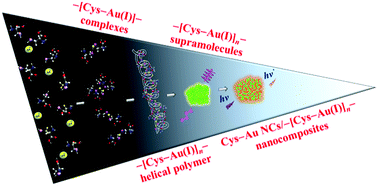The effect of ligand–ligand interactions on the formation of photoluminescent gold nanoclusters embedded in Au(i)–thiolate supramolecules†
Abstract
In this study, we prepared photoluminescent L-cysteine (Cys)-capped gold nanoclusters (Cys–Au NCs) via NaBH4-mediated reduction of aggregated coordination polymers (supramolecules) of –[Cys–Au(I)]n–. The –[Cys–Au(I)]n– supramolecules with interesting chiral properties were formed through simple reactions of chloroauric acid (HAuCl4) with Cys at certain pH values (pH 3–7). The –[Cys–Au(I)]n– polymers could self-assemble into –[Cys–Au(I)]n– supramolecules with irregular morphologies and diameters larger than 500 nm through stacked hydrogen bonding and zwitterionic interactions between Cys ligands and through Au(I)⋯Au(I) aurophilic interactions in solutions with pH values ≤7. The photoluminescent Au NCs (quantum yield = 11.6%) dominated by a Au13 core were embedded in –[Cys–Au(I)]n– supramolecules after NaBH4-mediated reduction. The optical and structural properties of Cys–Au NCs/–[Cys–Au(I)]n– nanocomposites were investigated, revealing that the interaction between Cys ligands plays a critical role in the self-assembly of –[Cys–Au(I)]n– supramolecules and in the formation of photoluminescent Cys–Au NCs embedded in the supramolecules. To further demonstrate that the photoluminescence properties and structures of the nanocomposites are mediated by the intermolecular forces of thiol ligands, other thiol ligands (L-penicillamine, L-homocysteine, 3-mercaptopropionic acid, and L-glutathione) and a ligand-crosslinking agent [bis(sulfosuccinimidyl) suberate; BS3] were used. We concluded that the electrostatic interactions, hydrogen bonding and steric effects dominate the polymer self-assembly into thiol-ligand–Au(I) supramolecules and thus the formation of Au NCs. Our study provides insights into the bottom-up synthesis of photoluminescent Au NCs from thiol-ligand–Au(I) complexes, polymers, and supramolecules. The hybrid Au NCs/–[Cys–Au(I)]n– nanocomposites can potentially be employed as drug carriers and bioimaging agents.



 Please wait while we load your content...
Please wait while we load your content...